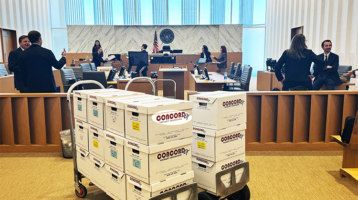LOWER LITIGATION COSTS?
“A single technology tool to support the complete e-discovery workflow simply does not exist.”
Ed Silverstein, Law Technology News
Corporate legal departments are increasingly like other parts of the business, and are expected to manage costs. This year will find many legal departments trying to control litigation spending on outside counsel, according to roundtables conducted by HBR Consulting in cities across the country in November 2014.
Roundtable attendees included law department personnel from over 50 companies, the majority of which were Fortune 500 companies. The roundtables focused on reviewing the results of HBR’s 2014 Law Department Survey.
According to the survey, outside counsel fees are up to 70 percent of discovery costs, so e-discovery is another focus to reduce the number of documents going to law firms.
To help manage these costs, HBR Consulting said that 21 percent of those participating in the roundtables last year plan to purchase e-discovery software in the next one or two years and 42 percent will enhance or upgrade what was already implemented. Some will add more e-discovery staff , which is often based on the maturity of the company’s program. More aggressive hiring is planned in Los Angeles, but only 18 percent of companies in the Northeast plan to add staff with 45 percent expecting to keep the same staffing level.
“[The year] 2015 will be a year focusing on efforts to reduce the costs of litigation by introducing efficiency in e-discovery and applying advanced technology where appropriate,” Bobbi Basile, managing director of HBR Consulting, explained in an interview with Legaltech News.
For both legal departments and vendors, this year will also be a year of learning about the technology and its uses. For instance, some legal departments must find the right size e-discovery for their organization based on size, number of legal matters and their budget.
Yet, they cannot ignore e-discovery technology because opposing attorneys and judges increasingly expect its use. “The bar has been raised,” Basile said. “Ignorance is not a defense.”
One of the challenges legal departments face is that e-discovery needs to be accomplished “in a way that’s most applicable,” Basile explained. “I think they want to [implement new predictive coding technology] because they see a significant opportunity for cost savings, but are not sure how to do it in a way that makes sense,” she added. Sometimes the use of the technology can create more questions than answers, she said, adding that users of the technology will find they still are early in the “learning cycle.”
One of the needed areas in the market is the ability to manage multiple projects in a single platform. Legal departments must be able to figure out how much they paid outside counsel to review documents. There is no dashboard to provide that information. Data are on different platforms involving different people. That makes management of costs more difficult to achieve.
“You can’t manage what you can’t measure,” Basile said.
“A single technology tool to support the complete e-discovery workflow simply does not exist,” HBR explained in a report. The consulting group added that a tech toolkit is needed that will allow for: analytics, collection, legal hold/preservation, processing, review and production. “Additionally, project management, audit tracking, reporting and the ability to generate metrics need to factor into the requirements for an e-discovery toolkit,” the report said.


